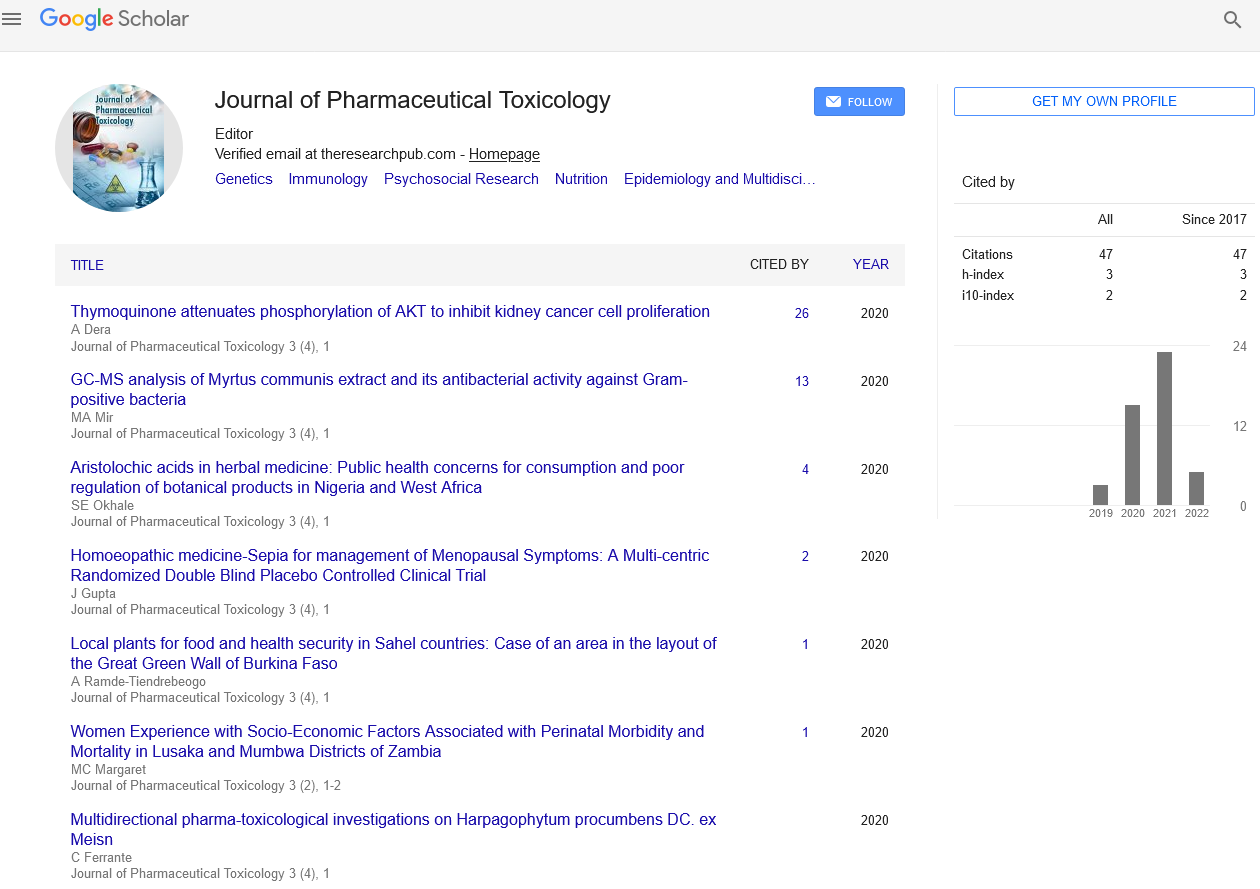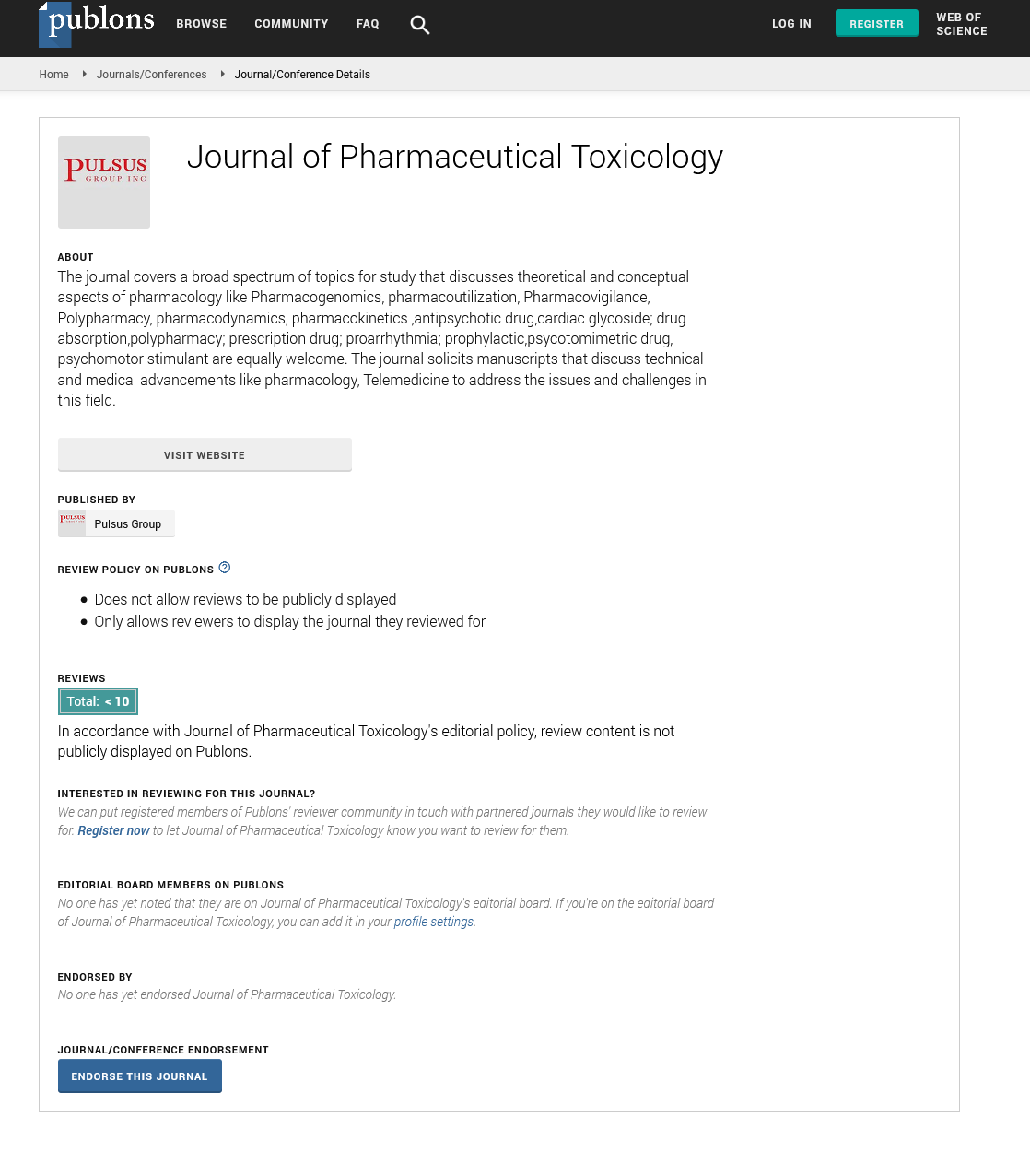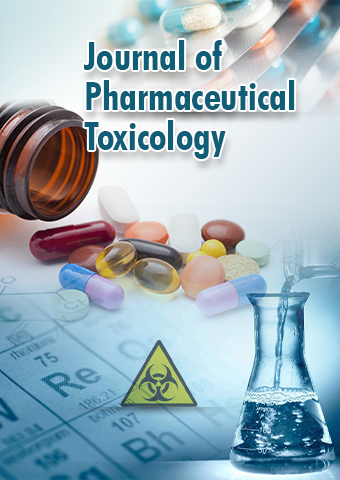Commentary - Journal of Pharmaceutical Toxicology (2023) Volume 6, Issue 3
The Role of Pharmaceuticals in Modern Healthcare: A Comprehensive Analysis
University of Waikato, New Zealand
Received: 01-June-2023, Manuscript No. oajpt-23-99811; Editor assigned: 05-June-2023, PreQC No. oajpt-23-99811 (PQ); Reviewed: 19- June-2023, QC No. oajpt-23-99811; Revised: 21-June-2023, Manuscript No. oajpt-23-99811 (R); Published: 28-June-2023; DOI: 10.37532/ jpt.2023.6(3).64-66
Abstract
Introduction
Precision medicine, also known as personalized medicine, has emerged as a groundbreaking approach in the field of healthcare and pharmaceuticals. This innovative approach aims to tailor medical treatments and therapies to individual patients based on their genetic makeup, lifestyle, and environmental factors. Precision medicine has the potential to revolutionize the pharmaceutical industry by improving treatment efficacy, reducing adverse reactions, and accelerating drug discovery and development. This article explores the recent advances in precision medicine and their impact on the pharmaceutical landscape.
Genomic medicine plays a pivotal role in precision medicine. Advances in DNA sequencing technologies and the availability of large-scale genomic databases have enabled researchers to identify genetic variations associated with diseases and drug responses. Pharmaceutical companies are now developing targeted therapies that specifically address these genetic alterations, leading to more effective treatments with fewer side effects. Examples include targeted cancer therapies like HER2 inhibitors for breast cancer and BRAF inhibitors for melanoma.
Pharmacogenomics combines the fields of pharmacology and genomics to study how an individual’s genetic makeup influences their response to drugs. By analyzing genetic variations that impact drug metabolism, efficacy, and toxicity, pharmacogenomics allows healthcare providers to make informed decisions about drug selection and dosage. Pharmaceutical companies are increasingly incorporating pharmacogenomic data into drug development and labeling to optimize treatment outcomes and reduce adverse reactions [1-4].
Discussion
Biomarkers are measurable indicators that can be used to diagnose diseases, assess disease progression, and predict treatment responses. In precision medicine, biomarkers play a crucial role in identifying patient subgroups that are most likely to benefit from a specific treatment. Companion diagnostics, which are tests that identify these biomarkers, are becoming an integral part of pharmaceutical development. They enable targeted therapy selection, ensuring that patients receive the most appropriate treatment based on their individual characteristics.
The advent of electronic health records (EHRs), wearable devices, and other digital health technologies has generated massive amounts of real-world data. Pharmaceutical companies are leveraging this data to gain insights into treatment outcomes, safety profiles, and patient populations. Artificial intelligence (AI) and machine learning algorithms are being employed to analyze these vast datasets, identifying patterns, predicting disease progression, and identifying potential drug targets. AI-driven approaches also facilitate the discovery of new drug candidates by analyzing vast chemical and biological databases.
Precision medicine requires collaboration among various stakeholders, including pharmaceutical companies, academic institutions, healthcare providers, and regulatory bodies. Initiatives such as the All of Us Research Program in the United States and the 100,000 Genomes Project in the United Kingdom aim to collect and analyze genomic and health data from large populations. Encouraging data sharing and collaboration enables researchers and pharmaceutical companies to accelerate drug development, validate findings, and enhance the understanding of disease mechanisms. Precision medicine holds great promise for transforming the pharmaceutical industry by enabling personalized treatments, optimizing drug development, and improving patient outcomes. As our understanding of genetics and disease mechanisms continues to advance, pharmaceutical companies will increasingly embrace precision medicine approaches, leading to more targeted and effective therapies. Collaboration, data sharing, and the integration of advanced technologies like genomics and AI will be crucial in harnessing the full potential of precision medicine to revolutionize the pharmaceutical landscape [5-7].
In the field of pharmaceuticals, targeted drug delivery systems have emerged as a groundbreaking approach that offers precise and efficient drug delivery to specific cells, tissues, or organs in the body. These systems have the potential to revolutionize the way we treat diseases by improving drug efficacy, reducing side effects, and enhancing patient outcomes. This article explores recent advancements in targeted drug delivery systems and their impact on pharmaceutical treatment.
Nanotechnology has paved the way for significant advancements in targeted drug delivery. Nanoparticles, liposomes, and other nanoscale carriers can be engineered to encapsulate drugs and deliver them to specific sites in the body. By modifying their size, surface properties, and functionalization, these nanoparticles can selectively interact with target cells, ensuring precise drug delivery. This approach has shown promise in various fields, including cancer treatment, where targeted nanoparticles can deliver chemotherapy drugs directly to tumor cells while minimizing damage to healthy tissues. Antibody-drug conjugates (ADCs) represent a cutting-edge class of targeted therapeutics.
ADCs combine the specificity of monoclonal antibodies with the potency of cytotoxic drugs. The antibody component recognizes and binds to specific antigens expressed on the surface of cancer cells, delivering the attached drug directly to the target cells. This approach enhances drug selectivity, reduces systemic toxicity, and improves therapeutic efficacy. Recent advancements in ADC technology have resulted in the development of novel ADCs with improved stability, payload capacity, and targeting capabilities [8,9].
Stimuli-responsive drug delivery systems are designed to release drugs in response to specific physiological cues or external stimuli. These systems can be triggered by factors such as pH, temperature, enzyme activity, or light. By harnessing these triggers, researchers can develop smart drug delivery systems that release drugs only at the desired location and time. For example, pH-responsive nanoparticles can remain stable in the bloodstream but release the drug payload selectively in the acidic tumor microenvironment. This approach improves drug accumulation at the target site and reduces off-target effects [10].
Conclusion
Gene therapy holds tremendous potential for treating genetic disorders and certain types of cancers. However, efficient delivery of therapeutic genes to target cells remains a significant challenge. Recent advancements in targeted gene delivery systems aim to overcome these obstacles. Viral vectors, such as adenoassociated viruses (AAVs) and lentiviruses, can be modified to selectively infect specific cell types and deliver therapeutic genes. Additionally, non-viral delivery systems, including lipidbased nanoparticles and polymer-based carriers, are being developed to enhance gene delivery efficiency and minimize immune responses. Targeted drug delivery systems have opened up new avenues in pharmaceutical treatment, offering improved therapeutic outcomes and reduced side effects. Nanotechnology, antibodydrug conjugates, stimuli-responsive systems, and gene therapy delivery systems are among the key advancements in this field. As research continues and technology evolves, the development of more precise and efficient drug delivery systems holds great promise for personalized medicine and the treatment of various diseases.
Acknowledgement
None
Conflict of Interest
None
References
- Hill–Taylor B, Walsh KA, Stewart S et al. Effectiveness of the STOPP/START (Screening Tool of Older Persons’ potentially inappropriate Prescriptions/Screening Tool to Alert doctors to the Right Treatment) criteria: Systematic review and meta–analysis of randomized controlled studies. J Clin Pharm Ther. 41, 158–169 (2016).
- Tommelein E, Mehuys E, Petrovic M et al. Potentially inappropriate prescribing in community–dwelling older people across Europe: A systematic literature review. Eur J Clin Pharmacol. 71, 1415–1427.
- Sadozai L, Sable S, Le E Roux et al. International consensus validation of the POPI tool (Pediatrics: Omission of Prescriptions and Inappropriate prescriptions) to identify inappropriate prescribing in pediatrics. PLoS ONE .15, 47–72 (2018).
- Barry E, Moriarty F, Boland F et al. The PIPc Study–application of indicators of potentially inappropriate prescribing in children (PIPc) to a national prescribing database in Ireland: A cross–sectional prevalence study. BMJ Open. 8, 69–556 (2019).
- Al–Badri A. Almuqbali J, Al–Rahbi K et al. A Study of the Paediatric Prescriptions at the Tertiary Care Hospital in Oman. J Pharmaceut Res.5, 17–56 (2020)
- Al–Maqbali, Haridass S, Hassali M et al. Analysis of Pediatric Outpatient Prescriptions in a Polyclinic of Oman. Glob J Med Res. 19, 2249–4618 (2019).
- Cullinan S, O’Mahony D, Fleming A et al. A meta–synthesis of potentially inappropriate prescribing in older patients. Drugs Aging.31, 631–638(2014).
- Liew TM, Lee CS, Goh Shawn KL et al. Potentially Inappropriate Prescribing Among Older Persons: A Meta–Analysis of Observational Studies. Ann Fam Med. 17, 257–266(2019).
- Crowe B, Hailey D. Cardiac picture archiving and communication systems and telecardiology – technologies awaiting adoption. J Telemed Telecare.8, 3–11(2002).
- Bouchier IA. Postmortem study of the frequency of gallstones in patients with cirrhosis of the liver. Gut. 10, 705-710.
Indexed at, Google Scholar, Cross ref
Indexed at, Google Scholar, Cross ref
Indexed at, Google Scholar, Cross ref


